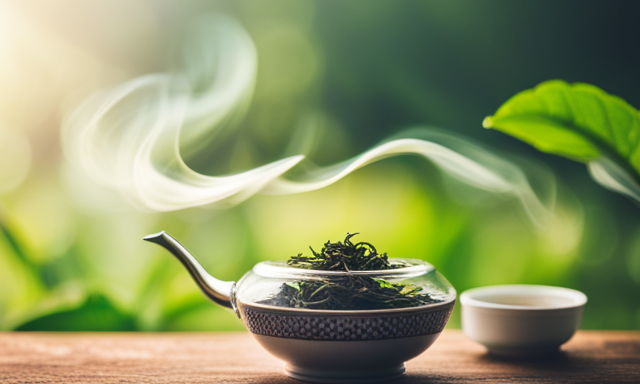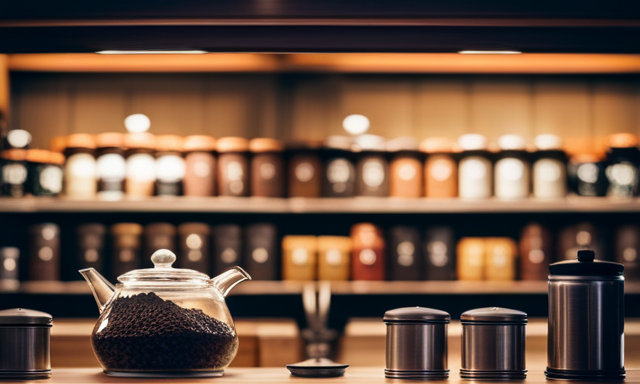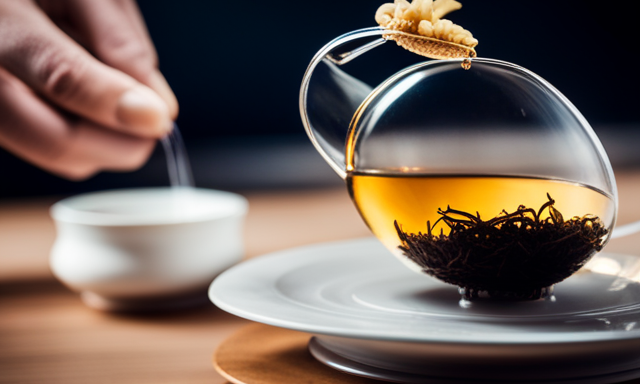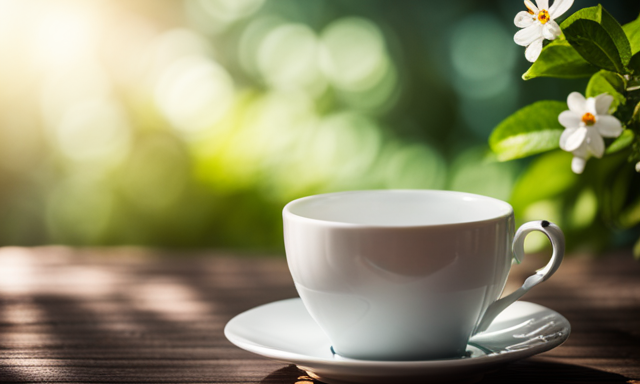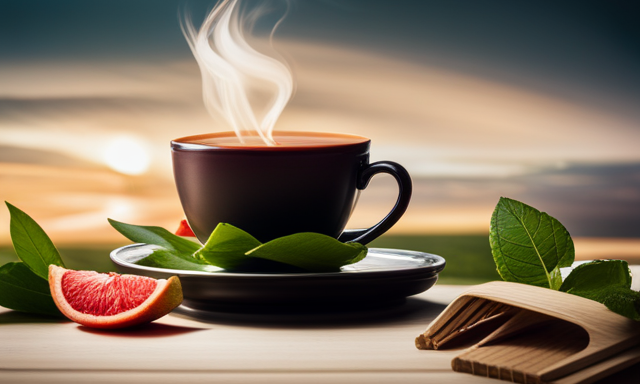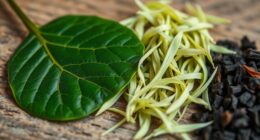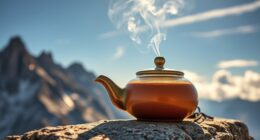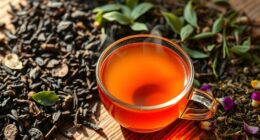As a tea enthusiast, I have always been fascinated by the diverse world of loose leaf teas. From delicate white teas to robust black teas, there is a tea for every mood and occasion.
However, one type of tea that has truly captivated my taste buds is oolong tea. With its unique blend of flavors and enticing aromas, oolong tea offers a truly exceptional tea-drinking experience.
In this article, I will be sharing my knowledge and expertise on how to make oolong loose leaf tea. From selecting the right tea leaves to brewing techniques and even exploring different blends and infusions, I will guide you through the art of preparing the perfect cup of oolong tea.
So, whether you are a seasoned tea connoisseur or just beginning to explore the world of loose leaf teas, join me on this journey as we delve into the wonderful world of oolong tea. Together, let’s unlock the secrets to creating a truly remarkable tea experience.
Key Takeaways
- Select high-quality oolong loose leaf tea with preferred flavor profiles, such as Tie Guan Yin, Da Hong Pao, or Oriental Beauty.
- Brew oolong tea using filtered or spring water and ceramic or glass teapots, with a water temperature of 195°F (90°C) to 203°F (95°C).
- Steep oolong tea for 3-5 minutes, adjusting steeping time for desired flavor profiles.
- Enjoy oolong tea hot or cold, and pair it with various foods based on the oxidation level, such as delicate desserts, tropical fruits, roasted nuts, or savory dishes.
Origins of Oolong Tea
Did you know that oolong tea has a fascinating history, with its origins traced back to the Fujian province in China? Oolong tea, also known as Wu Long tea, has been cultivated in this region for centuries, making it an integral part of Chinese tea culture.
The unique taste and aroma of oolong tea can be attributed to the intricate process of cultivation, which involves partially oxidizing the tea leaves. This delicate balance of oxidation gives oolong tea its distinctive flavor profile, ranging from floral and fruity to nutty and roasted.
The Fujian province’s favorable climate and fertile soil provide the perfect conditions for growing oolong tea, allowing its flavors to flourish.
Now that we understand the fascinating origins and cultivation of oolong tea, let’s dive into the health benefits it offers.
Health Benefits of Oolong Tea
Oolong tea offers various health benefits that can greatly enhance your well-being. Here are four reasons why you should consider incorporating oolong tea into your daily routine:
-
Weight Loss: Oolong tea has been shown to boost metabolism and aid in weight loss. It’s natural compounds help to increase fat oxidation and reduce body fat.
-
Heart Health: Drinking oolong tea regularly may help improve heart health by reducing cholesterol levels and lowering blood pressure. This can lower the risk of cardiovascular diseases.
-
Antioxidant Power: Oolong tea contains powerful antioxidants that can protect your body against free radicals. These antioxidants can help prevent chronic diseases and promote overall health.
-
Mental Alertness: The combination of caffeine and the amino acid L-theanine in oolong tea can improve mental alertness and focus, providing a natural energy boost.
Transitioning into the next section about selecting the right oolong loose leaf tea, it’s important to understand the various factors that contribute to the tea’s quality and flavor.
Selecting the Right Oolong Loose Leaf Tea
When it comes to finding the perfect oolong tea, exploring the nuances of flavor and quality is essential for a truly satisfying experience. Tea selection plays a crucial role in achieving the desired taste.
There are various types of oolong loose leaf teas available, each with its own unique characteristics and brewing requirements. Some popular varieties include Tie Guan Yin, Da Hong Pao, and Oriental Beauty. Consider the flavor profile you prefer, whether it’s floral, fruity, or roasted, and choose a tea that matches your taste preferences.
Additionally, pay attention to the quality of the leaves, looking for whole, unbroken leaves for the best taste. To enhance the brewing process, use filtered or spring water and experiment with different water temperatures and steeping times to find the perfect balance.
Transitioning into the subsequent section about brewing equipment and techniques, understanding the nuances of tea selection will help you further enhance your brewing experience.
Brewing Equipment and Techniques
When it comes to brewing oolong loose leaf tea, it’s important to have the right equipment and techniques. I recommend using a teapot or infuser specifically designed for loose leaf tea, as this allows for optimal steeping and extraction of flavors.
Additionally, paying attention to water temperature and steeping times is crucial in order to achieve the perfect cup of oolong tea. By following these recommendations, you can ensure a delightful and flavorful tea experience.
Recommended teapots and infusers
To enhance your tea brewing experience, you’ll want to consider using one of these recommended teapots and infusers.
When it comes to teapots, there are various designs to choose from. A popular option is a ceramic teapot, which helps retain heat and is easy to clean. Glass teapots are also great as they allow you to witness the beautiful unfurling of the oolong leaves.
As for infusers, stainless steel is the best material to use. It’s durable, doesn’t affect the flavor of the tea, and is easy to clean. Additionally, some infusers come with a built-in handle or chain for easy removal.
Now, let’s move on to the next section where we will discuss water temperature and steeping times for the perfect cup of oolong tea.
Water temperature and steeping times
Now that we’ve discussed the recommended teapots and infusers for brewing oolong loose leaf tea, let’s move on to another important aspect of tea preparation: water temperature and steeping times.
The temperature and steeping process play a crucial role in extracting the flavors and aromas of oolong tea leaves.
For oolong tea, it’s generally recommended to use water that’s around 195°F (90°C) to 203°F (95°C). This temperature range allows the tea leaves to unfurl and release their flavors without scorching them.
Steeping times can vary depending on the type of oolong tea, but a good starting point is around 3-5 minutes. However, it’s important to note that oolong tea is known for its multiple infusions, so you can experiment with longer or shorter steeping times to find your preferred flavor profile.
Now that we’ve covered water temperature and steeping times, let’s move on to the next section where we’ll learn how to prepare the perfect cup of oolong tea.
Preparing the Perfect Cup of Oolong Tea
First, steep the oolong loose leaf tea for 2-4 minutes, allowing the leaves to unfurl and release their flavors fully. Did you know that on average, a teaspoon of oolong loose leaf tea contains around 30-40 milligrams of caffeine?
To further enhance your oolong tea experience, consider exploring the various flavor profiles and tea pairings. Oolong teas can range from light and floral to rich and roasted, offering a wide spectrum of tastes to suit your preferences. For example, a lightly oxidized oolong like Tie Guan Yin has a delicate, floral aroma and pairs well with fruity desserts, while a more heavily roasted oolong like Da Hong Pao has a toasty, nutty flavor that complements savory dishes like roasted meats or spicy stir-fries.
Understanding the different flavor profiles and pairings of oolong tea will allow you to discover new and exciting combinations that elevate your tea-drinking experience. Now, let’s delve into the world of flavor profiles and pairings to further enhance your oolong tea enjoyment.
Flavor Profiles and Pairings
Discovering the diverse flavor profiles and perfect pairings of oolong tea will take your tea-drinking experience to new heights. Here are four flavor pairings and brewing techniques that’ll enhance your oolong tea experience:
-
Floral Delight: Brew a lightly oxidized oolong tea like Tie Guan Yin, and pair it with delicate desserts like lavender macarons or jasmine-infused pastries. The floral notes of the tea will harmonize beautifully with the sweet aromas of the treats.
-
Fruity Fusion: Opt for a medium to heavily oxidized oolong, such as Oriental Beauty, and enjoy it alongside tropical fruits like pineapple or lychee. The fruity flavors of the tea will complement the natural sweetness of the fruits, creating a refreshing taste.
-
Nutty Indulgence: Choose a roasted oolong like Da Hong Pao and savor it with roasted nuts like almonds or chestnuts. The toasty and nutty flavors of both the tea and the nuts will create a rich and indulgent combination.
-
Savory Serenade: For a unique experience, pair a dark roasted oolong like Wuyi Rock tea with savory dishes like roasted duck or grilled seafood. The tea’s smoky undertones will complement the savory flavors, enhancing the overall taste.
By exploring these flavor pairings and brewing techniques, you’ll uncover the true potential of oolong tea. Transitioning into the subsequent section about oolong tea rituals and traditions, let’s delve into the cultural practices that surround this exquisite beverage.
Oolong Tea Rituals and Traditions
Oolong tea rituals and traditions are an essential part of the tea-drinking culture in China. The traditional Chinese tea ceremony, known as Gongfu Cha, is a meticulous and precise practice that has been passed down through generations. It involves the careful preparation and presentation of oolong tea, focusing on the art of brewing and the appreciation of the tea’s aroma and flavor.
Additionally, oolong tea holds cultural significance in various countries, such as Taiwan and Japan, where it’s revered for its health benefits and unique taste.
Traditional Chinese tea ceremonies
Immerse yourself in the enchanting world of Traditional Chinese tea ceremonies and let the soothing aroma of oolong loose leaf tea transport you to a place of tranquility and serenity.
Chinese tea rituals have a rich history dating back thousands of years, and they’re deeply rooted in the country’s culture and traditions. These ceremonies aren’t just about brewing tea; they’re about creating a spiritual experience and connecting with nature.
The Chinese have developed various tea brewing techniques, each with its own unique style and purpose. From the meticulous Gongfu tea ceremony to the simple art of steeping tea leaves in a teapot, these rituals highlight the importance of patience, precision, and mindfulness.
As we delve into the cultural significance of oolong tea in different countries, we’ll discover the diverse ways in which this beloved beverage is cherished and revered.
Cultural significance of oolong tea in different countries
Let yourself be transported to different countries and experience the cultural significance of oolong tea as you explore the unique ways in which this beloved beverage is cherished and revered.
Oolong tea holds a special place in the cultural rituals of various countries. In China, it’s often served during traditional tea ceremonies, symbolizing respect, hospitality, and harmony. In Taiwan, oolong tea is an integral part of social gatherings, reflecting the country’s rich tea culture.
Apart from its cultural significance, oolong tea also boasts numerous medicinal uses. It’s believed to aid digestion, promote weight loss, and improve overall health. Its antioxidant properties make it a popular choice among health-conscious individuals.
As we delve into the next section on storing and preserving oolong tea, it’s important to understand the cultural and medicinal value this tea holds.
Storing and Preserving Oolong Tea
To ensure the rich flavor of your Oolong tea remains intact, it’s crucial that you store it in an airtight container. Oolong tea is delicate and can easily absorb odors from its surroundings, so preserving its taste requires proper storage techniques.
Avoid exposure to air, moisture, heat, and light, as they can degrade the quality of the tea. Opt for opaque containers that block out sunlight and choose a cool, dry place for storage. It’s also essential to keep your Oolong tea away from strong-smelling substances, such as spices or coffee, as they can affect its aroma.
By following these storage solutions and preserving techniques, you can maintain the freshness and flavor of your Oolong tea for a longer period.
Now, let’s delve into exploring Oolong tea blends and infusions.
Exploring Oolong Tea Blends and Infusions
When it comes to enjoying oolong tea, there are numerous options to explore. One popular choice is to try herbal and fruit blends with oolong tea, which can add a delightful twist to the traditional flavor.
Additionally, there are innovative recipes available that incorporate oolong tea into cocktails and desserts, allowing you to experiment and create unique and delicious creations.
Popular herbal and fruit blends with oolong tea
One of the most delightful aspects of oolong tea is the wide variety of popular fruit blends that can be enjoyed with it. These blends not only add a burst of flavor to the tea but also provide additional health benefits.
Some popular fruit blends include peach oolong, mango oolong, and strawberry oolong. These blends are created by combining dried fruit pieces with the oolong tea leaves, allowing them to infuse together and create a harmonious flavor profile.
Oolong tea recipes using these fruit blends can be found online or in tea recipe books, offering endless possibilities for tea lovers to explore.
As we move on to the next section, we will discover innovative recipes for incorporating oolong tea into cocktails and desserts, showcasing the versatility of this beloved tea.
Innovative recipes for incorporating oolong tea into cocktails and desserts
Get ready to tantalize your taste buds with the innovative and mouthwatering ways you can infuse oolong tea into delectable cocktails and desserts, taking your tea experience to a whole new level of deliciousness!
Oolong tea’s unique flavor profile and versatility make it a perfect ingredient for creating refreshing and creative cocktail recipes. Try mixing oolong tea with fresh fruits, herbs, and a splash of alcohol for a refreshing and sophisticated beverage.
For dessert lovers, incorporating oolong tea into sweet treats like cakes, ice creams, and custards can add a subtle yet distinctive flavor that will impress your guests. The floral and toasty notes of oolong tea complement a variety of ingredients, making it a versatile addition to your culinary repertoire.
Now let’s dive into the world of oolong tea brands and where to buy, to continue exploring the wide range of options this tea has to offer.
Oolong Tea Brands and Where to Buy
Discover the finest oolong tea brands and their locations to purchase, ensuring a delightful and authentic tea-drinking experience. Oolong tea, renowned for its unique taste and health benefits, can be found in various brands that offer exceptional quality. Here are some notable oolong tea brands and where you can purchase them:
| Brand | Location |
|---|---|
| Teavana | Online, select retail stores |
| Harney & Sons | Online, specialty tea shops |
| The Republic of Tea | Online, gourmet stores |
| Mighty Leaf | Online, natural food stores |
| Adagio Teas | Online, tea specialty stores |
These brands provide a wide range of oolong tea options, allowing tea enthusiasts to explore different flavors and aromas. When brewing oolong tea, it is recommended to use water just below boiling point and steep for approximately 3-5 minutes. This brewing technique helps bring out the tea’s unique flavors and reap its numerous health benefits, such as aiding digestion and promoting weight loss. Explore these brands and savor the exquisite flavors of oolong tea while enjoying its many health benefits.
Frequently Asked Questions
How long does oolong loose leaf tea stay fresh?
Oolong loose leaf tea stays fresh for up to two years when stored properly in an airtight container away from sunlight and strong odors. However, it may gradually lose its flavor and aroma over time.
Can I reuse oolong tea leaves for a second steeping?
Yes, you can definitely re-steep oolong tea leaves for a second infusion. It not only saves money but also offers the benefits of a milder flavor profile and increased health benefits from the tea leaves.
Are there different grades of oolong loose leaf tea?
There are indeed different grades of oolong loose leaf tea. The flavors can vary greatly, from floral and fruity to roasted and nutty. Properly storing oolong tea is essential to maintain its freshness and flavor.
What is the caffeine content in oolong loose leaf tea?
The caffeine content in oolong loose leaf tea can vary, but it generally contains less caffeine than black tea and coffee. Along with its unique flavor, oolong tea offers numerous health benefits.
Are there any specific water temperature and steeping times for different types of oolong tea?
For different types of oolong tea, it’s important to consider the water temperature and steeping time. The optimal water temperature for oolong tea ranges from 180°F to 205°F, and steeping time can vary between 3 to 5 minutes.
Conclusion
In conclusion, making oolong loose leaf tea isn’t just a process, but an art form that requires patience and attention to detail. By following the proper brewing techniques and selecting the right tea leaves, you can create a truly exceptional cup of oolong tea.
Whether you’re a tea enthusiast or a beginner, exploring the world of oolong tea can open up a whole new realm of flavors and aromas. For example, Sarah, a busy professional, found that starting her day with a cup of oolong tea helped improve her focus and productivity throughout the day.
So why not embark on your own oolong tea journey and discover the countless benefits it has to offer?

